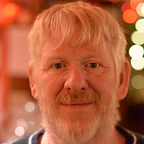The Most Dangerous Environmental Myth
The great 20th century inventor R. Buckminster Fuller spoke of the myth of the artificial. In his view, we can not create anything that does not adhere to the laws of physics and chemistry. His concern was that the word artificial implies that humans are separate from nature and that this myth of separation enables us to damage and destroy the very environment that our lives depend on. As the philosopher, Alan Watts famously said, “We grow out of this earth in exactly the same way an apple grows out of a tree.”
Consider: The largest volcanic eruption on which we have firm data happened in Iceland during 1783–1784. When Mt. Laki blew, 565 square miles were covered with ash. Sunlight was unable to reach the ground for months. Sulphur plumes displaced oxygen. All of the plants died. Soon after, all of the animals and humans starved to death. I live in a world where I can easily walk to a store and get something to eat in the middle of the night during a snowstorm. My senses report no imminent threat to my food supply, my safety seems secure.
We can go several weeks without food, several days without water, and only a few minutes without air. The perception that we are separate from the Earth is an illusion, a deadly illusion. As philosopher Alan Watts said, “We grow out of this Earth in much the same way an apple grows out of a tree.” Without plants burrowing their roots into the soil and sending their photon collectors — leaves — into the sky, we would all be dead. Our survival is dependent on the sun, a nonstop thermonuclear reactor located a convenient 93 million miles away. Any closer and it would fry us; any farther away and we would freeze. The energy it releases provides the sustenance upon which all earthly life depends. Plants have learned how to store that energy in clusters of carbon and hydrogen. When we eat, our blood carries those carbohydrates to our cells where their captured energy is released, fueling our very existence.
Back in 1969, who would have predicted that the most profound impact resulting from our journey to the moon was the view of the Earth as seen from space? This visual sensory input drove home, as never before, the fact that there is only one Earth, that if we blow it here there is nowhere else to go. The emergence of a global identity began with those pictures of Earth from space. This marks when we first recognized that we do indeed live on “Spaceship Earth,” as Buckminster Fuller liked to put it.
From snow lichen in the arctic tundra to microbes that cluster around thermal vents in the deep ocean floor, we find that life is endlessly versatile, adaptable, resilient, and innovative. This same life animates our body, regulates our breathing, and beats our heart. When we anchor our awareness in our aliveness, becoming present to the fact that we are, confidence and resourcefulness ensue. We feel secure, allow ourselves vulnerability, and participate in life. We recognize that the same aliveness that flows through us also flows through others and throughout nature. Thus we experience connection and inclusion, our dependence on the Earth becomes vivid and wondrous, and we thrive.
There is little disagreement that our global situation is unsustainable, that we are in need of dramatic transformation. There is much disagreement about what that transformation should be and how best to accomplish it. How can we galvanize our efforts into coherent action that will effectively address our global challenges? Our current situation is the result of billions of individual and diverse decisions made each moment. Amid this chaotic immensity, what impact can one person have?
Decisions are made and actions taken by individuals. Change and transformation flows through us; we are all change agents. Remembering our connection to the Earth, our dependence on food, water, and air, provides an effective guide for our decisions. It brings coherence to our actions and provides a basis for us to pool our resources so that we can accomplish the truly miraculous. It reminds us that we must nurture our community so that our community can support us, that we are a part of the Earth every bit as much as it is a part of us. This insight galvanizes our efforts into action that will effectively address our global challenges.
There is nothing more powerful than life, and that very life resides within us. It resides within you!
